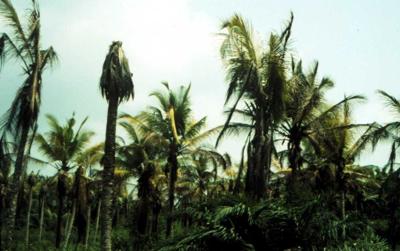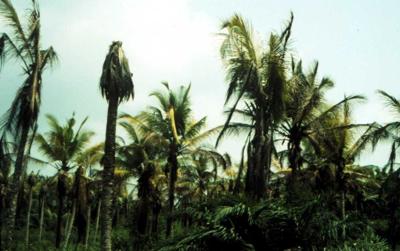


Lethal yellowing (<i>Phytoplasma</i>)
Symptoms include necrosis of inflorescences, yellowing of leaves and premature shedding of all fruit (nut fall) regardless of their developmental stage. Aborted nuts often develop a brown-black calyx-end rot reducing seed viability. Premature nut fall is accompanied or followed by inflorescence necrosis. This symptom is most readily observed as newly mature inflorescences emerge from the spathe. Normally light yellow to creamy white in colour; affected inflorescences are instead partially blackened (necrotic) usually at the tips of flower spikelets.
As disease progresses, additional emergent or unemerged inflorescences show more extensive necrosis and may be totally discoloured. Such symptom intensification results in the death of most male flowers and an associated lack of fruit set. Yellowing of the leaves usually starts once necrosis has developed on two or more inflorescences and discolouration is more rapid than that associated with normal leaf senescence. Yellowing begins with the older (lowermost) leaves and progresses upward to involve the entire crown. Yellowed leaves turn brown, desiccate and die. In some cases, the advent of this symptom is seen as a single yellow leaf (flag leaf) in the mid-crown. Affected leaves often hang down forming a skirt around the trunk for several days before falling.
A putrid basal soft rot of the newly emerged spear (youngest leaf) occurs once foliar yellowing is advanced. Spear leaf collapse and rot of the apical meristem invariably precedes death of the palm at which point the crown topples away leaving a bare trunk. Infected palms usually die within 3 to 6 months after the appearance of the first symptoms.
Lethal yellowing symptomatology may be complicated by other factors. For example, non-bearing palms lack fruit and flower symptoms. Foliar discolouration also varies markedly among coconut ecotypes and hybrids. For most tall-type coconut palms, leaves turn a golden yellow before dying whereas on dwarf ecotypes leaves generally turn reddish to greyish-brown.
Phytoplasmas are transmitted in a persistent (circulative-propagative) manner primarily by insect vectors belonging to the families Cicadelloidae (leafhoppers) and Fulgoroidae (planthoppers).
- Use genetically resistant ecotypes ("Malayan Yellow Dwarf") and hybrids ("Malayan Yellow Dwarf" x "Panama Tall"). This is the only practical long-term solution to lethal yellowing.
